Organizational Behavior: Leadership Article Review and Analysis
VerifiedAdded on 2022/09/26
|5
|1048
|23
Report
AI Summary
This report provides an analysis of two Harvard Business Review (HBR) articles on leadership: "Discovering Your Authentic Leadership" and "In Praise of the Incomplete Leader." The review explores the concept of authentic leadership, emphasizing that leaders are made through life experiences and self-awareness, and it highlights the importance of building relationships and empowering others. The report also examines the idea of the "incomplete leader," suggesting that no single leader possesses all the necessary skills and that embracing this incompleteness can lead to greater authenticity. The author agrees with the concepts discussed in the articles and provides examples to support the leadership styles mentioned in the articles. The author concludes by outlining how these lessons will be applied in future work environments, focusing on self-reflection, relationship-building, and team collaboration.
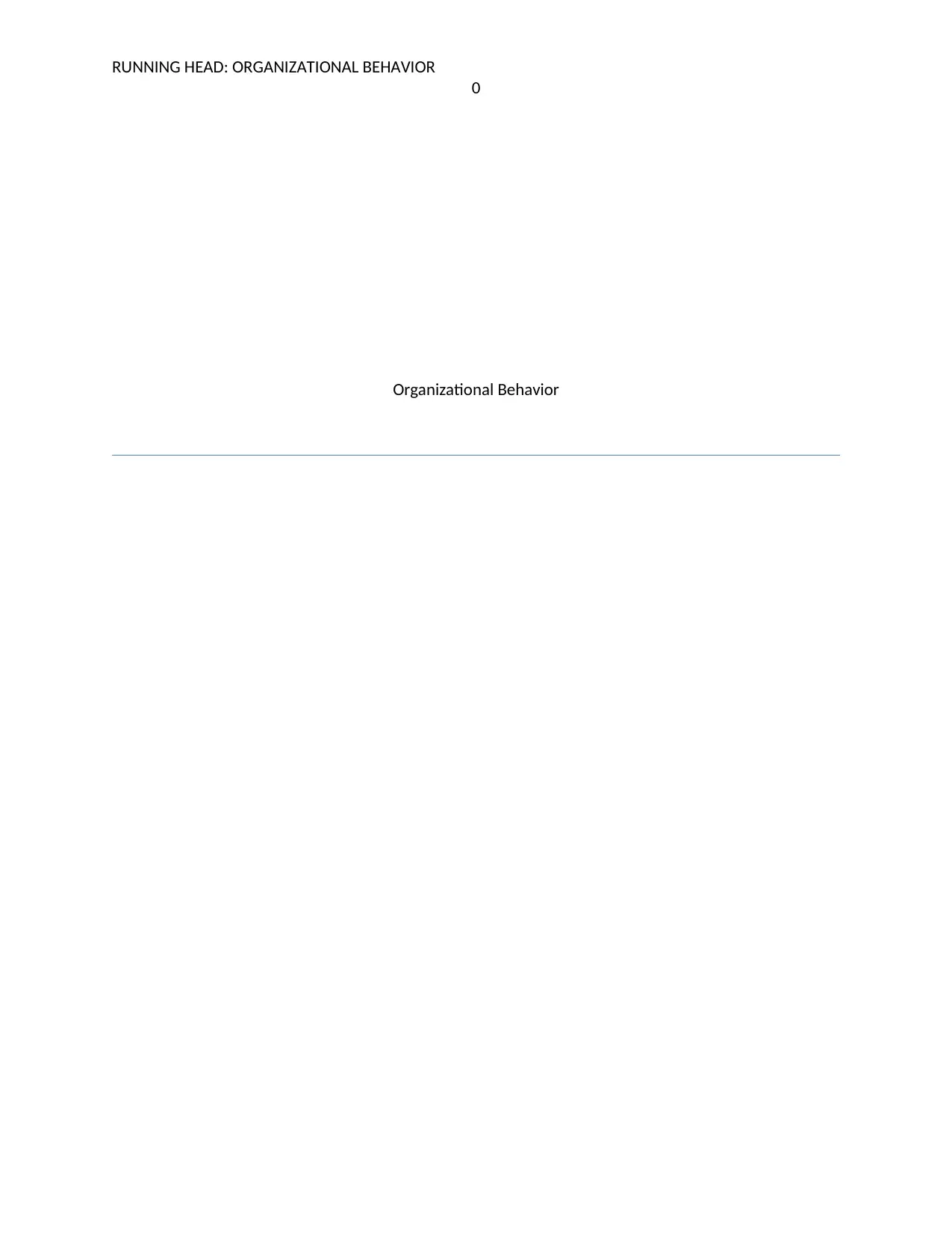
RUNNING HEAD: ORGANIZATIONAL BEHAVIOR
0
Organizational Behavior
0
Organizational Behavior
Paraphrase This Document
Need a fresh take? Get an instant paraphrase of this document with our AI Paraphraser
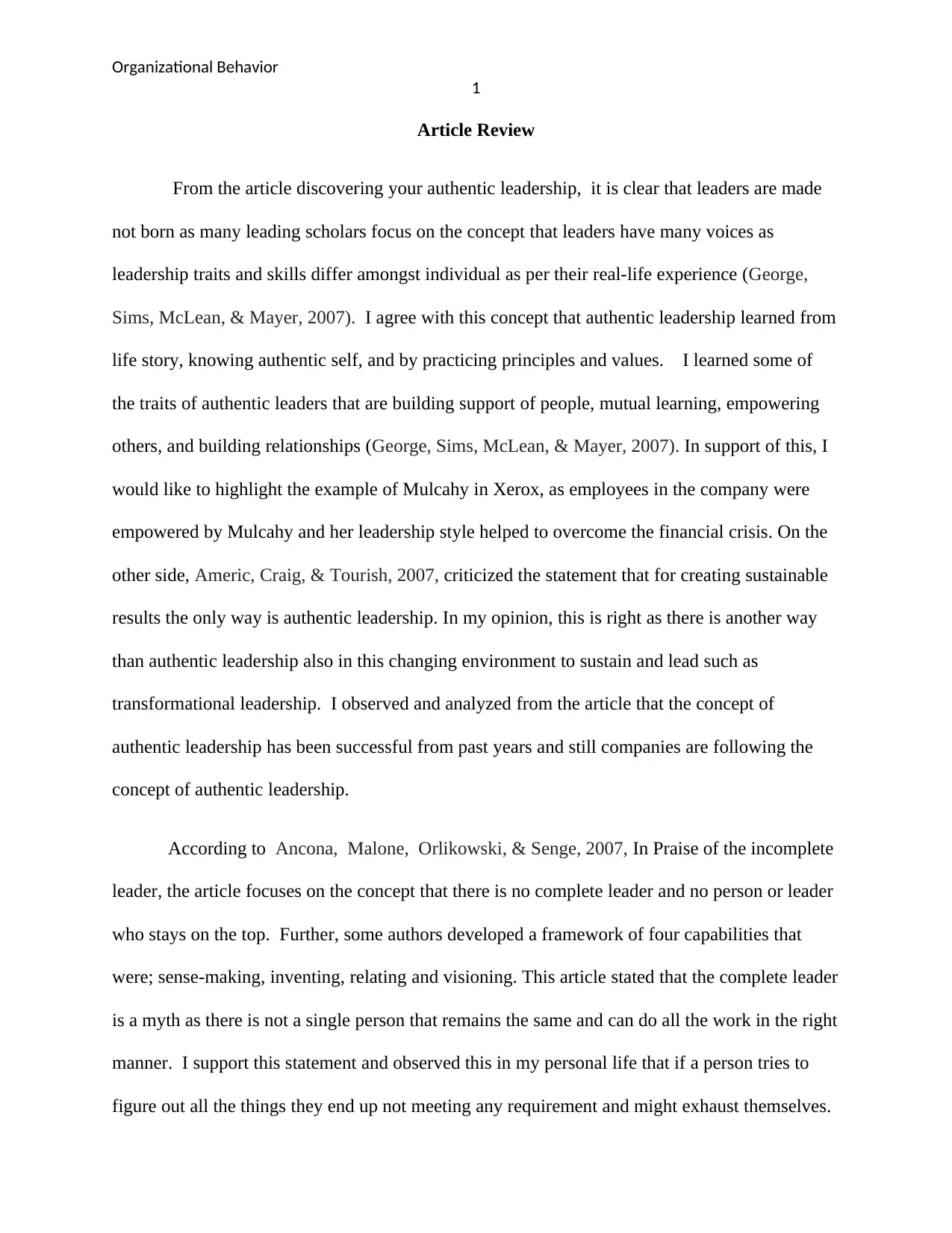
Organizational Behavior
1
Article Review
From the article discovering your authentic leadership, it is clear that leaders are made
not born as many leading scholars focus on the concept that leaders have many voices as
leadership traits and skills differ amongst individual as per their real-life experience (George,
Sims, McLean, & Mayer, 2007). I agree with this concept that authentic leadership learned from
life story, knowing authentic self, and by practicing principles and values. I learned some of
the traits of authentic leaders that are building support of people, mutual learning, empowering
others, and building relationships (George, Sims, McLean, & Mayer, 2007). In support of this, I
would like to highlight the example of Mulcahy in Xerox, as employees in the company were
empowered by Mulcahy and her leadership style helped to overcome the financial crisis. On the
other side, Americ, Craig, & Tourish, 2007, criticized the statement that for creating sustainable
results the only way is authentic leadership. In my opinion, this is right as there is another way
than authentic leadership also in this changing environment to sustain and lead such as
transformational leadership. I observed and analyzed from the article that the concept of
authentic leadership has been successful from past years and still companies are following the
concept of authentic leadership.
According to Ancona, Malone, Orlikowski, & Senge, 2007, In Praise of the incomplete
leader, the article focuses on the concept that there is no complete leader and no person or leader
who stays on the top. Further, some authors developed a framework of four capabilities that
were; sense-making, inventing, relating and visioning. This article stated that the complete leader
is a myth as there is not a single person that remains the same and can do all the work in the right
manner. I support this statement and observed this in my personal life that if a person tries to
figure out all the things they end up not meeting any requirement and might exhaust themselves.
1
Article Review
From the article discovering your authentic leadership, it is clear that leaders are made
not born as many leading scholars focus on the concept that leaders have many voices as
leadership traits and skills differ amongst individual as per their real-life experience (George,
Sims, McLean, & Mayer, 2007). I agree with this concept that authentic leadership learned from
life story, knowing authentic self, and by practicing principles and values. I learned some of
the traits of authentic leaders that are building support of people, mutual learning, empowering
others, and building relationships (George, Sims, McLean, & Mayer, 2007). In support of this, I
would like to highlight the example of Mulcahy in Xerox, as employees in the company were
empowered by Mulcahy and her leadership style helped to overcome the financial crisis. On the
other side, Americ, Craig, & Tourish, 2007, criticized the statement that for creating sustainable
results the only way is authentic leadership. In my opinion, this is right as there is another way
than authentic leadership also in this changing environment to sustain and lead such as
transformational leadership. I observed and analyzed from the article that the concept of
authentic leadership has been successful from past years and still companies are following the
concept of authentic leadership.
According to Ancona, Malone, Orlikowski, & Senge, 2007, In Praise of the incomplete
leader, the article focuses on the concept that there is no complete leader and no person or leader
who stays on the top. Further, some authors developed a framework of four capabilities that
were; sense-making, inventing, relating and visioning. This article stated that the complete leader
is a myth as there is not a single person that remains the same and can do all the work in the right
manner. I support this statement and observed this in my personal life that if a person tries to
figure out all the things they end up not meeting any requirement and might exhaust themselves.
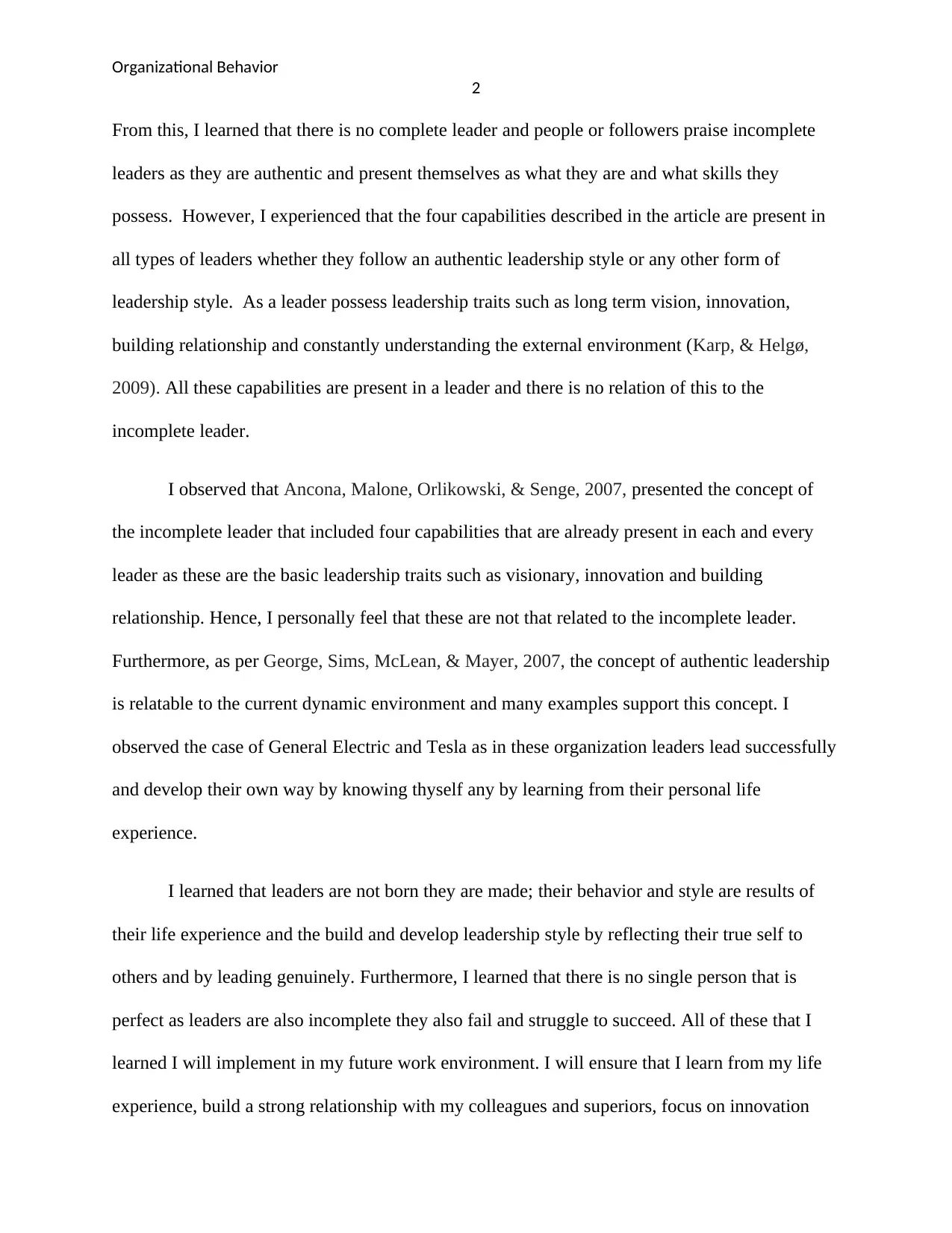
Organizational Behavior
2
From this, I learned that there is no complete leader and people or followers praise incomplete
leaders as they are authentic and present themselves as what they are and what skills they
possess. However, I experienced that the four capabilities described in the article are present in
all types of leaders whether they follow an authentic leadership style or any other form of
leadership style. As a leader possess leadership traits such as long term vision, innovation,
building relationship and constantly understanding the external environment (Karp, & Helgø,
2009). All these capabilities are present in a leader and there is no relation of this to the
incomplete leader.
I observed that Ancona, Malone, Orlikowski, & Senge, 2007, presented the concept of
the incomplete leader that included four capabilities that are already present in each and every
leader as these are the basic leadership traits such as visionary, innovation and building
relationship. Hence, I personally feel that these are not that related to the incomplete leader.
Furthermore, as per George, Sims, McLean, & Mayer, 2007, the concept of authentic leadership
is relatable to the current dynamic environment and many examples support this concept. I
observed the case of General Electric and Tesla as in these organization leaders lead successfully
and develop their own way by knowing thyself any by learning from their personal life
experience.
I learned that leaders are not born they are made; their behavior and style are results of
their life experience and the build and develop leadership style by reflecting their true self to
others and by leading genuinely. Furthermore, I learned that there is no single person that is
perfect as leaders are also incomplete they also fail and struggle to succeed. All of these that I
learned I will implement in my future work environment. I will ensure that I learn from my life
experience, build a strong relationship with my colleagues and superiors, focus on innovation
2
From this, I learned that there is no complete leader and people or followers praise incomplete
leaders as they are authentic and present themselves as what they are and what skills they
possess. However, I experienced that the four capabilities described in the article are present in
all types of leaders whether they follow an authentic leadership style or any other form of
leadership style. As a leader possess leadership traits such as long term vision, innovation,
building relationship and constantly understanding the external environment (Karp, & Helgø,
2009). All these capabilities are present in a leader and there is no relation of this to the
incomplete leader.
I observed that Ancona, Malone, Orlikowski, & Senge, 2007, presented the concept of
the incomplete leader that included four capabilities that are already present in each and every
leader as these are the basic leadership traits such as visionary, innovation and building
relationship. Hence, I personally feel that these are not that related to the incomplete leader.
Furthermore, as per George, Sims, McLean, & Mayer, 2007, the concept of authentic leadership
is relatable to the current dynamic environment and many examples support this concept. I
observed the case of General Electric and Tesla as in these organization leaders lead successfully
and develop their own way by knowing thyself any by learning from their personal life
experience.
I learned that leaders are not born they are made; their behavior and style are results of
their life experience and the build and develop leadership style by reflecting their true self to
others and by leading genuinely. Furthermore, I learned that there is no single person that is
perfect as leaders are also incomplete they also fail and struggle to succeed. All of these that I
learned I will implement in my future work environment. I will ensure that I learn from my life
experience, build a strong relationship with my colleagues and superiors, focus on innovation
⊘ This is a preview!⊘
Do you want full access?
Subscribe today to unlock all pages.

Trusted by 1+ million students worldwide
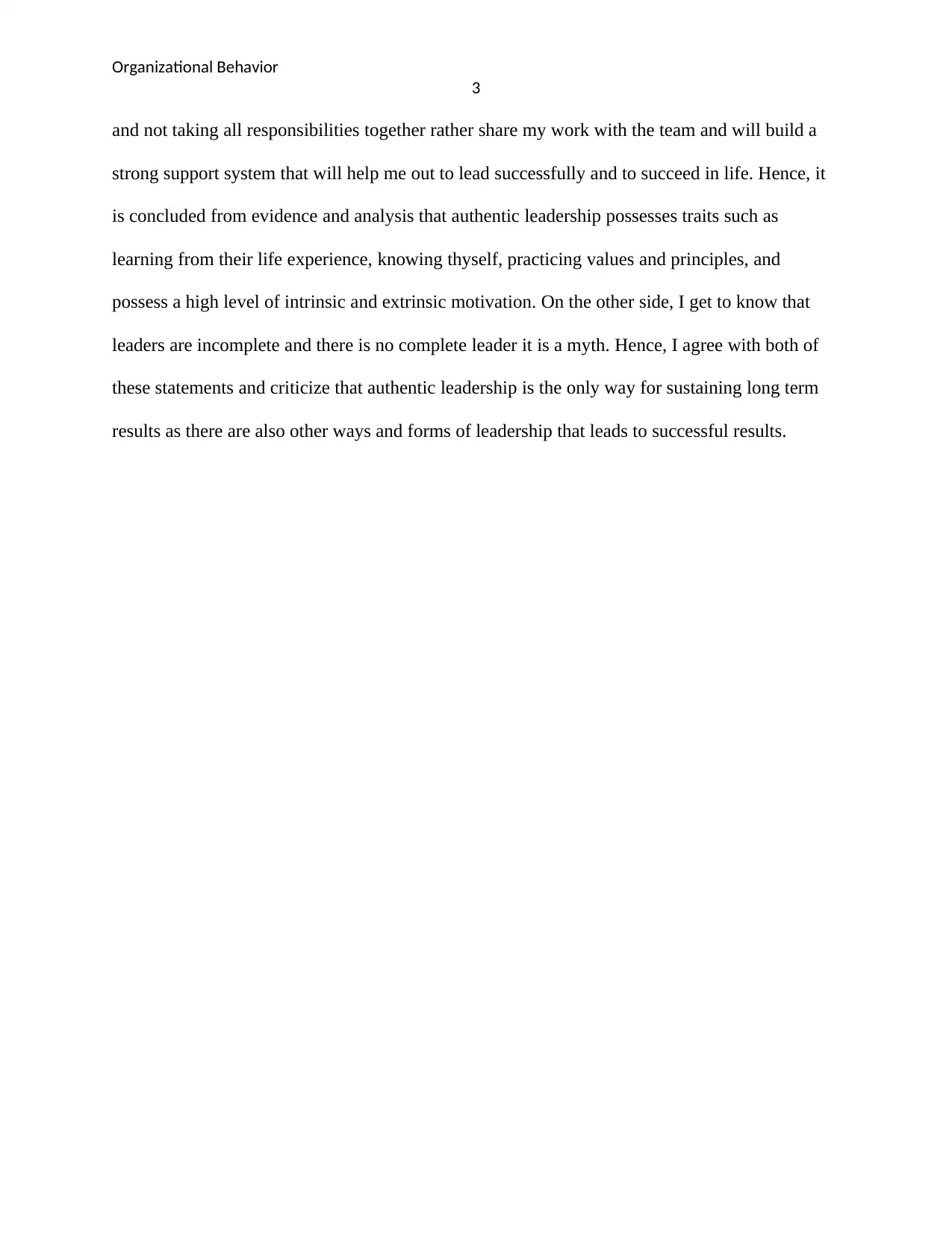
Organizational Behavior
3
and not taking all responsibilities together rather share my work with the team and will build a
strong support system that will help me out to lead successfully and to succeed in life. Hence, it
is concluded from evidence and analysis that authentic leadership possesses traits such as
learning from their life experience, knowing thyself, practicing values and principles, and
possess a high level of intrinsic and extrinsic motivation. On the other side, I get to know that
leaders are incomplete and there is no complete leader it is a myth. Hence, I agree with both of
these statements and criticize that authentic leadership is the only way for sustaining long term
results as there are also other ways and forms of leadership that leads to successful results.
3
and not taking all responsibilities together rather share my work with the team and will build a
strong support system that will help me out to lead successfully and to succeed in life. Hence, it
is concluded from evidence and analysis that authentic leadership possesses traits such as
learning from their life experience, knowing thyself, practicing values and principles, and
possess a high level of intrinsic and extrinsic motivation. On the other side, I get to know that
leaders are incomplete and there is no complete leader it is a myth. Hence, I agree with both of
these statements and criticize that authentic leadership is the only way for sustaining long term
results as there are also other ways and forms of leadership that leads to successful results.
Paraphrase This Document
Need a fresh take? Get an instant paraphrase of this document with our AI Paraphraser
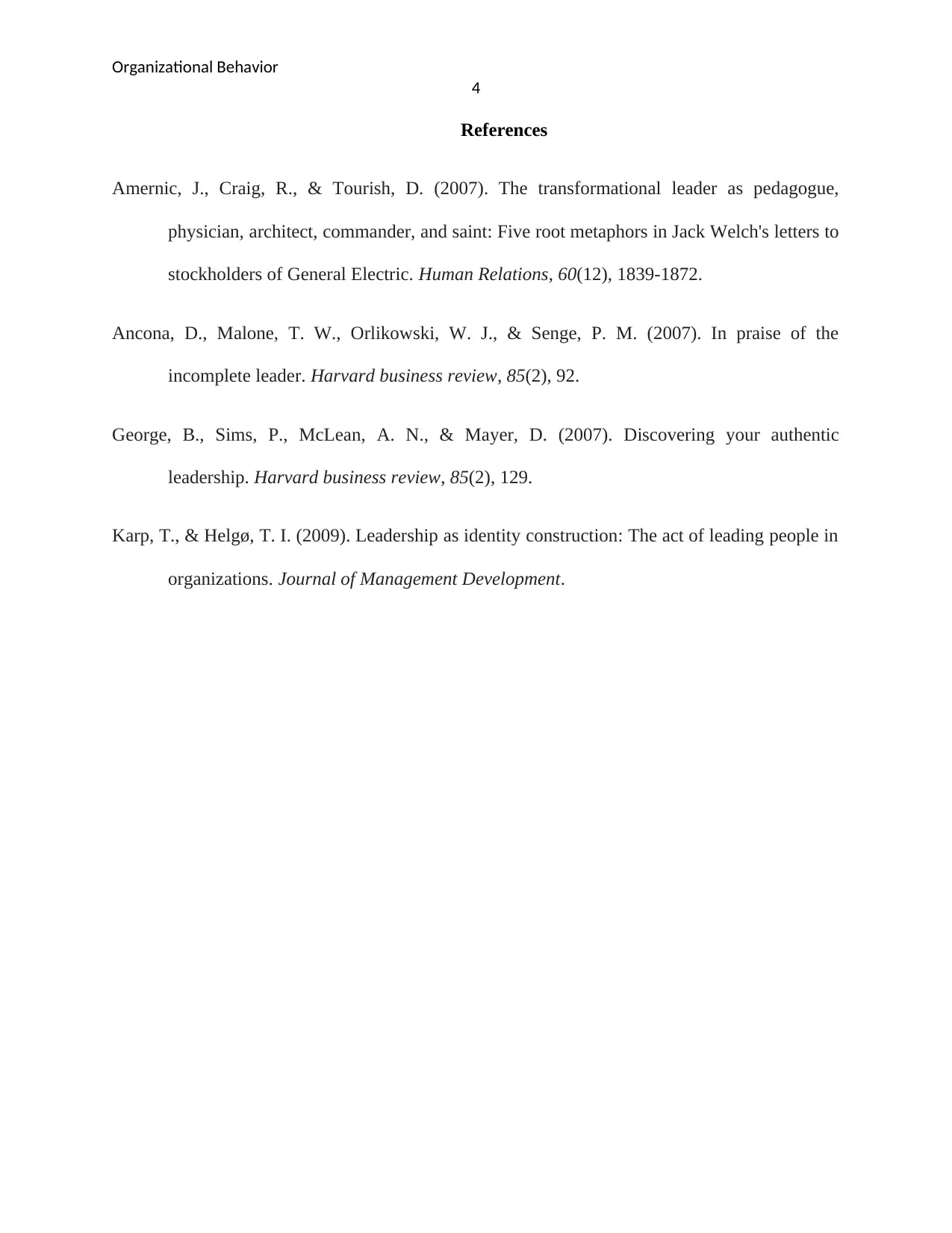
Organizational Behavior
4
References
Amernic, J., Craig, R., & Tourish, D. (2007). The transformational leader as pedagogue,
physician, architect, commander, and saint: Five root metaphors in Jack Welch's letters to
stockholders of General Electric. Human Relations, 60(12), 1839-1872.
Ancona, D., Malone, T. W., Orlikowski, W. J., & Senge, P. M. (2007). In praise of the
incomplete leader. Harvard business review, 85(2), 92.
George, B., Sims, P., McLean, A. N., & Mayer, D. (2007). Discovering your authentic
leadership. Harvard business review, 85(2), 129.
Karp, T., & Helgø, T. I. (2009). Leadership as identity construction: The act of leading people in
organizations. Journal of Management Development.
4
References
Amernic, J., Craig, R., & Tourish, D. (2007). The transformational leader as pedagogue,
physician, architect, commander, and saint: Five root metaphors in Jack Welch's letters to
stockholders of General Electric. Human Relations, 60(12), 1839-1872.
Ancona, D., Malone, T. W., Orlikowski, W. J., & Senge, P. M. (2007). In praise of the
incomplete leader. Harvard business review, 85(2), 92.
George, B., Sims, P., McLean, A. N., & Mayer, D. (2007). Discovering your authentic
leadership. Harvard business review, 85(2), 129.
Karp, T., & Helgø, T. I. (2009). Leadership as identity construction: The act of leading people in
organizations. Journal of Management Development.
1 out of 5
Your All-in-One AI-Powered Toolkit for Academic Success.
+13062052269
info@desklib.com
Available 24*7 on WhatsApp / Email
![[object Object]](/_next/static/media/star-bottom.7253800d.svg)
Unlock your academic potential
Copyright © 2020–2025 A2Z Services. All Rights Reserved. Developed and managed by ZUCOL.